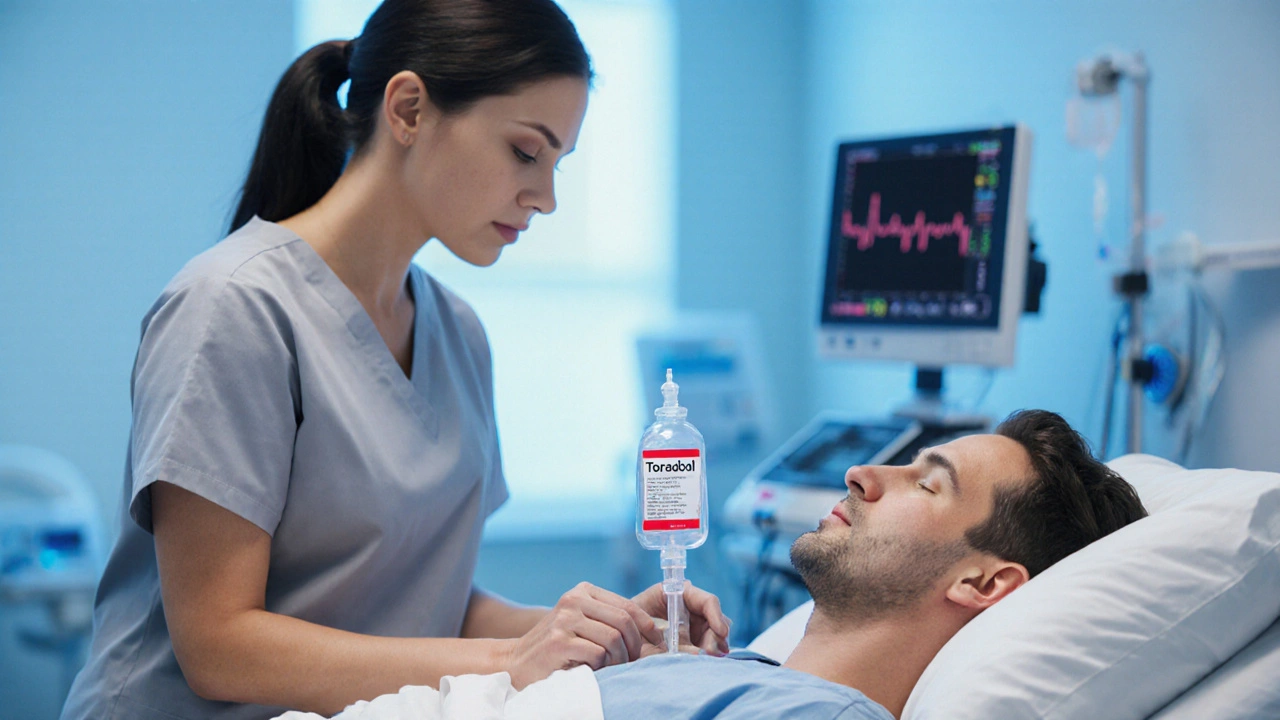Pain Medication Comparison Tool
Find Your Best Pain Relief Option
Answer these questions to determine which pain medication might be best for your situation.
When you need fast, strong pain relief, the first name that pops up is often Toradol (generic name ketorolac). It’s an NSAID that can knock out moderate‑to‑severe pain in a matter of minutes, but that power comes with a handful of caveats. If you’ve ever wondered whether another medication might give you similar relief with fewer headaches, you’re in the right place. Below we break down how Toradol measures up against the most common over‑the‑counter and prescription alternatives, so you can decide which option fits your situation best.
The fast‑acting nature of Toradol makes it a go‑to for post‑surgical pain, but that speed comes with strict usage limits.
Key Takeaways
- Toradol delivers rapid, opioid‑level pain relief but is limited to short‑term use (≤5 days).
- Ibuprofen and naproxen are gentler on the stomach but act slower and may need higher doses for severe pain.
- Celecoxib offers a lower gastrointestinal risk but can raise cardiovascular concerns.
- Acetaminophen is safe for most people but has little anti‑inflammatory effect.
- For breakthrough pain that won’t subside with NSAIDs, a short course of a weak opioid may be considered, but only under medical supervision.
What is Toradol (Ketorolac)?
Ketorolac is a potent non‑steroidal anti‑inflammatory drug (NSAID) that inhibits cyclo‑oxygenase (COX‑1 and COX‑2) enzymes, reducing the production of prostaglandins that cause pain and inflammation. Approved by the FDA in 1989, it comes as an injectable, oral tablet, and intramuscular formulation. The injectable route is the most common in hospitals for post‑operative pain because it reaches peak blood levels within 10‑20 minutes.
How Toradol Works and Typical Use
Because it blocks both COX‑1 and COX‑2, Toradol cuts the pain signal at its source. The standard adult dose for oral tablets is 10mg every 4-6hours, not to exceed 40mg per day or 5days total. Exceeding these limits raises the risk of serious gastrointestinal bleeding, kidney injury, and, in rare cases, cardiovascular events.
Clinical guidelines reserve Toradol for short‑term management of moderate‑to‑severe pain after surgeries, dental extractions, or trauma. It’s not meant for chronic conditions like arthritis because the safety window is too narrow.
Common Alternatives to Toradol
Below are the most frequently mentioned substitutes, each with its own strengths and weaknesses.
Ibuprofen is an over‑the‑counter NSAID that primarily targets COX‑2, offering pain relief for headaches, muscle aches, and mild inflammation. Typical dosing is 200‑400mg every 4-6hours, with a maximum of 1,200mg per day without prescription.
Naproxen is a longer‑acting NSAID that provides 8‑12hour coverage, making it useful for back pain or menstrual cramps. Adult dosing usually starts at 250mg twice daily, not exceeding 1,500mg per day.
Celecoxib is a COX‑2‑selective NSAID marketed under the brand name Celebrex. It spares the stomach lining better than non‑selective NSAIDs but may increase the risk of heart attacks in patients with existing cardiovascular disease. The usual dose for acute pain is 200mg once daily.
Acetaminophen (paracetamol) is an analgesic/antipyretic that works centrally rather than at the site of inflammation. It’s safe for most people up to 3,000mg per day (or 4,000mg under medical guidance) but offers little anti‑inflammatory benefit.
Diclofenac is a prescription NSAID often used for joint pain and postoperative pain. It can be taken as a 50mg tablet two to three times daily, but shares similar gastrointestinal risks to Toradol.
Pros and Cons of Each Option
Here's a quick glance at the trade‑offs you’ll face when you pick one of these drugs.
- Toradol (Ketorolac) - Pros: rapid onset, strong analgesia comparable to opioids; Cons: limited to 5 days, high GI and renal risk.
- Ibuprofen - Pros: widely available, inexpensive, decent anti‑inflammatory effect; Cons: stomach irritation, needs multiple daily doses.
- Naproxen - Pros: long duration, good for chronic musculoskeletal pain; Cons: similar GI risk, potential cardiovascular concerns at high doses.
- Celecoxib - Pros: COX‑2 selectivity spares stomach; Cons: higher cost, possible heart attack risk.
- Acetaminophen - Pros: safe for most, no stomach upset; Cons: no anti‑inflammatory action, liver toxicity at high intake.
- Diclofenac - Pros: strong anti‑inflammatory, useful for joint pain; Cons: GI bleeding risk similar to Toradol, can affect liver enzymes.
Side‑by‑Side Comparison
| Medication | Typical Dose | Onset of Relief | Duration | Max Daily Dose | Key Risks |
|---|---|---|---|---|---|
| Toradol (Ketorolac) | 10mg PO q4‑6h or 30mg IV/IM q6h | 10‑20min (IV/IM), 30‑60min (oral) | 4‑6h | 40mg PO / 120mg IM/IV per day (max 5days) | GI bleeding, renal impairment, cardiovascular events |
| Ibuprofen | 200‑400mg PO q4‑6h | 30‑60min | 4‑6h | 1,200mg OTC, 3,200mg Rx | Stomach upset, ulcer risk, mild kidney effect |
| Naproxen | 250mg PO BID | 30‑60min | 8‑12h | 1,500mg OTC, 1,500mg Rx | GI bleeding, cardiovascular risk at high dose |
| Celecoxib | 200mg PO q24h | 1‑2h | 12‑24h | 400mg per day (max 800mg in special cases) | Elevated heart attack risk, rare kidney issues |
| Acetaminophen | 500‑1,000mg PO q4‑6h | 30‑45min | 4‑6h | 3,000mg OTC (4,000mg under supervision) | Liver toxicity at high doses |
| Diclofenac | 50mg PO BID | 30‑60min | 6‑8h | 150mg per day | GI bleeding, possible liver enzyme rise |
When Toradol May Be the Better Choice
If you’re in a post‑surgical recovery unit, need pain control within minutes, and can commit to a short‑term regimen, Toradol often wins. Its rapid onset rivals that of intravenous opioids while avoiding the drowsiness and dependence potential. However, the drug should be avoided if you have:
- Active peptic ulcer disease or a history of gastrointestinal bleeding.
- Severe kidney disease (eGFR <30mL/min/1.73m²).
- Uncontrolled hypertension or recent cardiovascular events.
- Pregnancy, especially in the third trimester.
For patients who can’t tolerate NSAIDs at all, acetaminophen combined with a short course of a weak opioid (like codeine) might be safer, but that shifts the risk profile to opioid‑related side effects.
Choosing an Alternative: Decision Checklist
- Pain intensity & urgency: Need relief in under an hour? Lean toward Toradol or injectable NSAIDs.
- Duration of therapy: If you need more than five days, pick ibuprofen, naproxen, or celecoxib.
- GI health: History of ulcers? Favor celecoxib (COX‑2 selective) or acetaminophen.
- Kidney function: Reduce NSAID load; consider acetaminophen or a low‑dose opioid.
- Cardiovascular risk: Avoid celecoxib if you have coronary artery disease; stick with non‑selective NSAIDs at the lowest effective dose.

Safety Tips for All NSAIDs
Regardless of which NSAID you choose, follow these best practices:
- Take the lowest effective dose for the shortest time possible.
- Never combine two NSAIDs simultaneously (e.g., ibuprofen with naproxen).
- Take them with food or a full glass of water to protect the stomach.
- Stay hydrated; NSAIDs can reduce kidney perfusion, especially in older adults.
- Check with your pharmacist or doctor before mixing NSAIDs with blood thinners, ACE inhibitors, or lithium.
Real‑World Example: Post‑Dental Extraction
Sarah, a 28‑year‑old without any medical issues, had her wisdom teeth removed. Her dentist prescribed a single 30mg IV dose of Toradol followed by 10mg tablets every 6hours for two days. She reported pain scores dropping from 8/10 to 2/10 within an hour of the first dose. Because Sarah had no ulcer history, she tolerated the short course without stomach upset.
John, a 55‑year‑old with mild hypertension, needed the same procedure but was told to avoid Toradol due to his blood pressure meds. He took ibuprofen 400mg every 6hours and acetaminophen 500mg alternating every 3hours. His pain eased more slowly, reaching 3/10 after three hours, but he experienced mild stomach discomfort, prompting a switch to naproxen after the dentist’s follow‑up.
These stories illustrate how the same clinical scenario can lead to different drug choices based on individual health factors.
Bottom Line
Toradol is a heavyweight painkiller that shines in short, acute situations where speed matters. For everyday aches, chronic inflammation, or when you need a longer safety margin, alternatives like ibuprofen, naproxen, celecoxib, or acetaminophen usually make more sense. Use the checklist above, talk to a healthcare professional, and match the medication to your personal risk profile.
Frequently Asked Questions
Can I take Toradol and ibuprofen together?
No. Combining two NSAIDs spikes the risk of stomach bleeding and kidney injury without adding meaningful pain relief. Choose one or space them at least 8hours apart if a doctor explicitly orders both.
Is Toradol safe for dental extraction pain?
Dentists often prescribe a single short course of Toradol for severe post‑extraction pain, provided you have no ulcer history and normal kidney function. The drug’s fast action can keep you comfortable while the site heals.
What is the biggest difference between ibuprofen and naproxen?
Naproxen lasts longer (8‑12hours) compared to ibuprofen’s 4‑6hour window, so you need fewer pills each day. However, naproxen may carry a slightly higher cardiovascular risk at high doses.
Can I use celecoxib if I have high blood pressure?
Celecoxib can raise blood pressure in some patients. If your hypertension is well‑controlled and you need a stomach‑friendly NSAID, your doctor might still prescribe it, but they’ll monitor your blood pressure closely.
What should I do if I miss a Toradol dose?
Take the missed dose as soon as you remember, unless it’s almost time for the next scheduled dose. Do not double‑dose; just continue with the regular schedule.

Comments (11)